1
A New Data-Aided Synchronization Scheme for
FBMC-OQAM Systems
Xiadong Liu, Daiming Qu, Tao Jiang
Wuhan National Laboratory for Optoelectronics, School of Electronics Information and Communications,
Huazhong University of Science and Technology, Wuhan, China.
E-mail: xiadongliu@hust.edu.cn, qudaiming@hust.edu.cn, tao.jiang@ieee.org
Abstract—Although the Filter bank multicarrier with offset
quadrature amplitude modulation (FBMC-OQAM) systems are
robust against double selective fading channels, it unfortunately is
still sensitive to timing offset and carrier frequency offset (CFO)
errors. To solve this synchronization problem,
in this paper,
we propose a new data-aided timing and CFO synchronization
scheme, that exploits the conjugate-symmetry property of a
properly designed training sequence. In addition, the sliding
window algorithm is applied to the proposed scheme to further
improve synchronization performance in multipath fading chan-
nels. Simulation results verify that the proposed scheme achieves
good performance in AWGN channel and multipath fading
channels,
in terms of timing capture probability, minimum-
square-error (MSE) of timing offset and CFO estimation and bit
error rate (BER) versus signal-to-noise ratio (SNR). Moreover, it
can achieve timing and frequency synchronization independently
in steps with relatively lower implementation complexity.
Keywords—FBMC-OQAM, Data-aided timing and CFO syn-
chronization scheme, conjugate-symmetry property, sliding win-
dow algorithm, lower implementation complexity.
I. INTRODUCTION
Recently, Filter bank multicarrier with offset quadrature
amplitude modulation (FBMC-OQAM) have been attracting
increasing attention, as a promising alternative to the con-
ventional orthogonal frequency division multiplexing (OFDM)
technique [1], [2]. Due to the use of the pulse shaping filter on
each subcarrier, FBMC-OQAM systems have lower spectral
sidelobes than OFDM systems [3]. In addition, compared to
OFDM, FBMC-OQAM does not require the insertion of cyclic
prefix (CP) [4], resulting in higher spectral efficiency. As a
result, the FBMC-OQAM has been viewed as a promising
physical layer technique for 5G wireless networks [5].
However, like all other multicarrier modulation schemes,
FBMC-OQAM systems are in general more sensitive to syn-
chronization errors than single-carrier systems [6]. In spite of
the advantage of having well-localized filters, timing offset
and carrier frequency offset (CFO) are very critical to the
performance of the FBMC-OQAM system. The performance
Copyright (c) 2016 IEEE. Personal use of this material
is permitted.
However, permission to use this material for any other purposes must be
obtained from the IEEE by sending a request to pubs-permissions@ieee.org.
This work was supported in part by National High Technology Development
863 Program of China under Grant 2015AA01A710, the National Science
Foundation (NSFC) for Distinguished Young Scholars of China with Grant
number 61325004, the NSFC with Grant numbers 61301129, 61571200, the
Key Project of Hubei Province in China with Grant 2015BAA074, the open
research fund of National Mobile Communications Research Laboratory, , and
Southeast University under Grant 2014D09.
degradation resulting from synchronization errors is much
more severe in low SNR scenarios due to the residual in-
terference. In addition, the existence of CFO destroys the or-
thogonality among subcarriers, then introduces inter-subcarrier
interference (ICI). Therefore, a more accurate and reliable
synchronization method must be proposed.
Several synchronization algorithms have been investigated
in connection with FBMC-OQAM systems. Among them, two
categories were addressed. One category is blind schemes.
A blind joint symbol timing and CFO estimator was firstly
proposed by exploiting the unconjugated cyclostationarity of
the received OFDM/OQAM signal [7]. Then, a blind CFO
estimator based on the linear unbiased estimation principle
was proposed in [8]. But the blind estimators requires wide
observation window with long processing delay. Usually, we
adopt data-aided schemes. Based on the identical structure of
the training sequence, the TR1 and TR2 methods were firstly
derived in [9]. Then, the MLS algorithm based on the least
squares (LS) approach was investigated in [10]. Considering
about multipath channels, the WBS scheme in [11] based on
sliding window was proposed. The arrival time of the first path
can be almost surely located in the WBS scheme, whatever the
channel power profile is. However, the above schemes usually
should jointly consider time and frequency synchronization,
that is to say, timing offset estimation and CFO estimation are
needed to conduct at the same time. This may bring relatively
higher implementation complexity for synchronization.
In this paper, we propose a new data-aided synchronization
scheme, that exploits the conjugate-symmetry property of a
properly designed training symbol. In multipath channels, we
apply the sliding window algorithm to improve the synchro-
nization performance. Moreover, the proposed scheme can
acheive timing and frequency synchronization independently
in steps, thus making the implementation complexity relatively
lower. The derived estimator does not require the knowledge
of the prototype filter with robust acquisition properties.
The rest of this paper is organized as follows. In section II,
after describing the system model of FBMC-OQAM systems,
the receive signal model in the presence of timing offset and
CFO and the detailed implement diagram of timing and carrier
frequency synchronization are reviewed. In section III, the
proposed timing offset and CFO estimation method is derived.
The simulation results are finally presented in section IV and
the conclusion is given in section V.
978-1-5090-2860-3/16/$31.00 ©2016 IEEE�
2
Fig. 1. The equivalent baseband diagram of an FBMC-OQAM system.
II. SYSTEM MODEL
B. Review of Synchronization Procedure
A. FBMC-OQAM System Model
As shown in Fig. 1, we consider the equivalent baseband
diagram of an FBMC-OQAM system, in which the subcarrier
number is M and subcarrier spacing is 1/T , with T being
the complex symbol interval. The transmitted symbol is real-
valued with frequency index m and time index n, and T /2
is the interval of real-valued symbols. am,2k and am,2k+1 are
obtained by taking the real and imaginary parts of a complex-
valued symbol from 22K-quadrature amplitude modulation
(QAM) constellation, respectively. g(k) is a symmetrical real-
valued pulse shaping filter, with the length KM, K is over-
lapping factor, usually takes as 4. We denote basis function as
gm,n(k) = gk − n M
ej2πmk/M ej(m+n)π/2. Therefore, the
equivalent baseband FBMC-OQAM signal is written as
2
M−1
ej2πmk/M ej(m+n)π/2
. (1)
k − n
s (k) =
am,n g
M
2
gm,n(k)
m=0
n∈Z
In FBMC-OQAM systems, we denote
∞
k=0
ζ p,q
m,n =
gm,n(k)g∗
p,q(k).
(2)
In this part, we would have a detailed review of the
received signal model in the presence of timing offset and CFO
and the implement diagram of timing and carrier frequency
synchronization.
For brevity, we firstly take no account of the influence of
channel. In the presence of the normalized timing offset τ and
CFO ∆f, the received signal in AWGN channel can be written
as
r(k) = s(k − τ )ej2π∆f·k/M + n(k),
(5)
where s(k) is the transmitted FBMC-OQAM signal and n(k)
denotes the zero-mean circular complex white Gaussian noise
n.
with power spectral σ2
In general, timing offset as well as carrier frequency offset
exists in FBMC-OQAM systems. Usually we may adopt data-
aided scheme based on training sequences. As shown in Fig. 2,
we compare the implement diagram of proposed scheme with
traditional schemes. In traditional synchronization schemes,
we usually jointly consider time and frequency synchroniza-
tion, i.e., timing offset estimation and CFO estimation are
needed to conduct at the same time, such as the TR1, TR2
and WBS scheme. Compared with traditional synchronization
schemes, we achieve timing and frequency synchronization
independently in steps in this paper. In detail, in the first
m,n = 1. Or ζ p,q
Note that when (m, n) = (p, q), ζ p,q
m,n is an
imaginary-valued number. Specially, when |p − m| > 1 or
|q− n| > 1, it can be considered that ζ p,q
m,n ≈ 0 [2]. In FBMC-
OQAM systems, the orthogonality condition can be written
as
1 m = p, n = q
∞
gm,n(k)g∗
= δm,pδn,q =
. (3)
p,q(k)
0
others
k=0
Through the channel, we can get the receive signal r (k) for
demodulation. The receive module is in corresponding with
transmit module. After the demodulation, it can be obtained
as
ˆam,n =
r(k)g(k − n
M
2
)e−j2πmk/M e−jπ(m+n)/2. (4)
∞
k=−∞
After channel equalization and taking the real part on ˆam,n,
the original real symbols can be obtained.
Fig. 2. The implement diagram of timing and frequency synchronization.
2jkMep2(1)jMkMep-[]sk[]gk0,ˆna1,ˆna1,ˆMna-[]gk[]gk2jnep-(1)2jnep+-(1)2jMnep-+-2jkMep-2(1)jMkMep--[]gk[]gk[]gk[]rkchannel2jnep(1)2jnep+(1)2jMnep-+2M2M2M2M2M2M0,na1,na1,Mna-Timing Offset compensatorCFO compensator()rk f ! ()synrkTiming Offset estimatorCFO estimator(a)The implement diagram of proposed synchronization scheme(b)The implement diagram of traditional synchronization scheme()rk Timing Offset compensatorTiming Offset estimator f CFOcompensatorCFOestimator()synrk�
M
4 −1
4 −1
m0=0
M
step, we use received signal to estimate time offset parameters
and take corresponding compensation; then, according to the
timing compensated signal, we conduct CFO estimation and
compensation. After the above two steps, we finally utilize the
synchronized signal for post-processing at the receiver, such
as demodulation, equalization etc.
III. PROPOSED TIMING AND CARRIER FREQUENCY
OFFSET ESTIMATOR
A. Training Sequence Design with Conjugate-Symmetry Prop-
erty
Firstly, this subsection aims to obtain a properly designed
training sequence satisfying conjugate-symmetry property,
which is similar to that
in OFDM systems [12], namely
s(A − B) = s∗(A + B) , where A is the conjugate-symmetry
center and B is the width. Specially, pilot symbols are trans-
mitted every fourth subcarrier at the n0th instant, i.e., on the
(m = 4m0)th subcarrier with m0 = 0, 1, ..., M/4 − 1, the
sequence can be obtained as
s0(k) =
a4m0,n0 g(k − n0M
2
j2π·4m0·k
M
e
)e
j(4m0+n0)π
2
=
a4m0,n0 g(k − n0M
2
.
By substituting k = KM + n0M − k to (6), we obtain
j2π·4m0·k
m0=0
jπn0
)e
e
M
2
(6)
s0(KM + n0M − k)
4 −1
M
=
a4m0,n0g(KM +
n0M
2
− k)e
j2π·4m0·(−k)
M
jπn0
2
e
. (7)
m0=0
In general, g(k) is a real-valued symmetrical pulse shaping
filter with the length of KM, i.e., g(k) = g(KM − k). Then,
it can be obtained as
g(k − n0M
2
) = g(KM − k+
n0M
2
).
(8)
For simplification, assume that n0 is odd, then e
2 =
±1. Comparing above equations (6), (7) and (8), it can be
0(KM + n0M−k). To easily illustrate the
obtained s0(k) = s∗
symmetry of training sequence, for k = 0, 1, ..., M/2− 1, it
can be rewritten as
jπn0
KM + n0M
s0(
2
− k) = s∗
0(
KM + n0M
+ k).
(9)
2
Obviously, the training sequence is conjugate-symmetry with
, which is suitable for timing offset
respect to k = KM +n0M
2
and CFO estimations.
However, due to the overlapping structure of the adjacent
FBMC-OQAM symbols, we should separate the pilot symbols
and data symbols by inserting zero-valued symbols. When the
number of zero-valued symbols is larger, the interference to
pilot symbols is smaller. However, the insertion of zero-valued
symbols introduces large overhead,
thus reduces spectrum
efficiency. Therefore, we should choose the appropriate num-
ber of zero-valued symbols to maintain good synchronization
performance while keeping number of zero-valued symbols as
small as possible.
B. Timing Offset Estimation
3
According to the above training sequence, we propose the
timing offset estimator as follows. Firstly, we denote
−k+τ )r(
KM + n0M
KM + n0M
2
2
+k+τ ).
(10)
M/2−1
R(τ )=
r(
k=0
Substituting (5) to (10) and extending it, we can obtain four
terms, including one signal term, one noise term and two cross
terms. In high SNR condition, the power of noise w(n) is
much lower than signal power, the noise and cross terms can
be ignored for simplicity. When the estimated timing offset
equals the real value, i.e., τ = τ, according to the conjugate-
symmetry property, it can be obtained
R(τ )≈
KM + n0M
+ k)
ej
4π(
KM +n0M
2
M
+τ )∆f
.
2
(11)
It can be noted that, each sum item has the same phase
, then the amplitude of their vector sum
ej
R(τ ) is relatively larger. Besides, we define
4π(KM +
+τ )∆f
n0M
2
M
s(
M/2−1
k=1
2
Q(τ ) = max
M/2−1
k=0
τ = arg maxτ
= arg maxτ
M (τ + m)
D−1
MD(τ ).
m=0
(15)
2
− k +τ )
2
+ k +τ )
,
2
KM + n0M
KM + n0M
r(
r(
|R(τ )|2
M (τ ) =
Q(τ )2 .
τ = arg maxτ
M (τ ).
to normalize R(τ ), then the final timing metric function can
2
be expressed as
,
(12)
(13)
Therefore, we get the estimated timing offset as
(14)
When τ = τ, R(τ ) is the linear in-phase superposition of
M/2− 1 samples and M (τ ) should be the largest. Whenτ =
τ, R(τ ) is the nonlinear superposition of M/2 − 1 samples,
and it is obvious smaller than that when τ = τ. Thus, it
symmetry property, M (τ ) is very sharp for accurate detection.
can be regarded as noise. In conclusion, due to the conjugate-
Moreover, considering the fact that the first path is not
always the instantaneous power strongest path in actual multi-
path fading channels, we should combine the above estimation
algorithm with sliding window algorithm [11] to improve
the accuracy of the timing synchronization. The core idea
of the sliding window algorithm is applying the final timing
metric function M (τ ) to a sliding window with fixed length
D(D > τmax) to obtain a new timing metric MD(τ ) , where
τmax is the maximum delay of the multipath channel, the
timing estimator is obtained as
�
C. CFO Estimation
4
In order to achieve accurate CFO estimation with a low
implementation complexity, an identical training symbol part
in the above subsetion III-A is proposed.
After achieving timing offset estimation, we should consider
about the identical property of the proposed training sequence,
then the following correlation expression can be obtained
R1(τ ) =
M−1
k=0
r∗(
KM + n0M
2
· r(
KM + n0M
2
− M
2
− M
2
+ k +τ )
+ d + k +τ ),
(16)
where d is the number of interval samples between two
identical training symbol parts.
As a result, the CFO can be estimated as
∆f (τ ) =
∠{R1(τ )}.
M
d
· 1
2π
(17)
Fig. 3. Capture probability of timing synchronization in AWGN and 802.22
A channels.
exactly estimate timing offset in per trial without errors. The
above results illustrate that the proposed estimator is unbiased
and can achieve perfect timing offset estimation in AWGN
channel.
In 802.22 A channel, with the increase of SNR, the capture
rate grows rapidly, and especially when SNR ≥ 10 dB, it is
up to a high value of 0.98. The proposed timing estimator can
reach almost same performance with the WBS scheme [11]
when SNR ≥ 10 dB, although a little but acceptable gap may
exist in low SNR. However, in the WBS scheme, one should
jointly consider timing offset estimation and CFO estimation
at the same time, while the proposed scheme can achieve the
above synchronization independently in steps with relatively
lower implementation complexity.
IV. SIMULATION RESULTS
In this section, the performance of the proposed synchro-
nization algorithm via computer simulations in both AWGN
and 802.22 A channel, the simulation parameters of FBMC-
OQAM systems are shown in Table I. The values of the CFO
∆f normalized to subcarrier spacing and the timing offset τ
normalized to sampling interval are uniformly distributed in
the range of [−1/4, 1/4] and {−M/4, ..., M/4}, respectively.
In order to present the performance of the proposed syn-
chronization scheme, we give key indicator of synchronization
estimator as follows. The capture rate of exactly estimating
timing offset per trial, P catch,
is used to evaluate the
performance of the proposed timing offset estimation. Usually,
the capture rate can be statistically illustrated and defined as
P catch = Nt/Ntotal, where Ntotal (large enough) is the
number of timing offset estimation trials and Nt is the number
of exact timing offset estimation. In multipath channels, the
mean squared error of timing offset estimator is defined as
M SE ST O=(τ − τ )2. Besides, the mean squared error of
CFO estimator is defined as M SE CF O=(∆f − ∆f )2.
TABLE I
SIMULATION PARAMETERS.
System Parameter
Number of subcarriers (M)
Modulation scheme
Prototype function
Number of pilot symbols
Value
256
QPSK
IOTA filters(length: 4M)
6
802.22 A Channel
Delay of Channel (Ts)
Gain of Channel (dB)
[ 0 2 4 7 11 14 ]
[ 0 -7 -15 -22 -24 -19 ]
Fig. 4. MSE of timing offset estimation in 802.22 A Channel.
A. Performance of timing offset estimator
Fig. 3 shows the performance of timing offset estimation
P catch versus SNR in AWGN and 802.22 A channels. It is
obvious that in AWGN channel, the capture rate remains 1
for all SNRs, which means that the proposed algorithm can
Fig. 4 shows the mean squared error of proposed timing esti-
mator in 802.22 A channel. When SNR ≥ 10 dB, MSE STO
is less than 100, which means that the mean error of per-trial is
lower than 1 sample. Therefore, the receiver needs to perform
proper channel estimation to complete demodulation.
05101520253000.10.20.30.40.50.60.70.80.91SNR dBP_catch Proposed(AWGN)Proposed(802.22 A)WBS(802.22 A)05101520253010−210−1100101102SNR dBMSE of timing offset estimation�
5
B. Performance of CFO estimator
Furthermore, in Fig. 5 we present the performance of the
proposed CFO estimator. Numerical results show that with
the increase of SNR, the mean square error decreases rapidly,
maintaining at a lower level for a relatively higher SNR level.
For the condition that MSE CFO reaches lower than 10−5,
we need to guarantee SNR ≥ 10dB in 802.22 A channel while
SNR ≥ 7dB in AWGN channel. The proposed CFO estimator
can reach almost same performance with the WBS scheme
when SNR ≥ 10dB. The proposed algorithm can achieve good
CFO estimation both in AWGN and 802.22 A channel.
Fig. 6. BER performance of FBMC-OQAM system in AWGN and 802.22
A channels.
The performance of the proposed estimator, that does not
require the knowledge of the prototype filter, has been assessed
via computer simulation both in AWGN and multipath chan-
nels. Simulation results have shown that the proposed scheme
can assure accurate timing offset and CFO estimation with
relatively lower implementation complexity due to that timing
and frequency synchronization can be achieved independently
in steps and robust acquisition properties.
Fig. 5. MSE of CFO estimation in AWGN and 802.22 A channels.
REFERENCES
C. BER Results
To gain some insight about the sensitivity of the FBMC-
OQAM signal in terms of BER on timing and carrier frequency
synchronization, Fig. 6 shows the BER verus SNR in AWGN
channel and 802.22 A channel due to the fact that the capture
rate remains 1 for all SNRs and excellent performance of CFO
estimator. Simulation results show that, the proposed synchro-
nization scheme can reach almost the same performance with
perfect synchronization in AWGN channel. Furthermore, in
802.22 A channel, when SNR ≥ 10 dB, the proposed syn-
chronization scheme can reach almost the same performance
with perfect synchronization. When SNR < 10 dB, there is
only a acceptable performance gap between them due to
the fact that the timing offset estimation error of per-trial
is relatively large as well as CFO estimation. In conclusion,
the proposed algorithm can achieve good synchronization, and
improve the system performance.
V. CONCLUSIONS
In this paper, we consider about the problem of timing and
carrier frequency synchronization for the FBMC-OQAM sys-
tems. In particular, we have derived a new data-aided symbol
timing and frequency synchronization scheme, that exploits the
conjugate-symmetry property of a properly designed training
symbol. Furthermore,
in multipath channel, we apply the
sliding window algorithm to improve timing offset estimation.
[1] P. Siohan, C. Siclet and N. Lacaille, “Analysis and Design of OQAM-
OFDM Systems based on Filterbank Theory,” IEEE Trans. Signal
Process., vol. 50, no. 5, pp. 1170-1183, May 2002.
[2] D. Kong, D. Qu, and T. Jiang, “Time Domain Channel Estimation for
OQAM-OFDM Systems: Algorithms and Performance Bounds,” IEEE
Trans. Signal Process., vol. 68, no. 2, pp. 322-330, Jan. 2014.
[3] D. Chen, D. Qu, T. Jiang and Y. He, “Prototype Filter Optimization
to Minimize Stopband Energy With NPR Constraint for Filter Bank
Multicarrier Modulation Systems,” IEEE Trans. Signal Process., vol.
61, no. 1, pp. 159-169, Jan. 2013.
[4] D. Qu, S. Lu and T. Jiang, “Multi-Block Joint Optimization for the Peak-
to-Average Power Ratio Reduction of FBMC-OQAM Signals,” IEEE
Trans. Signal Process., vol. 61, no. 7, pp. 1605-1613, Apr. 2013.
[5] M. Bellanger, “Physical Layer for Future Broadband Radio Systems,”
in Proc. IEEE RWS, pp. 436-439, Jan. 2010.
[10] T. Fusco, A. Petrella, and M. Tanda, “Data-aided Symbol Timing and
CFO Bank Multicarrier Systems,” IEEE Trans. Wireless Commun., vol.
8, no. 5, pp. 2705-2715, May 2009.
[11] G. Yang, H. Chen, S. Hu, G. Wu and S. Li, “Data-aided Joint Symbol
Timing and CFO Estimation for OFDM/OQAM systems,” in Proc. IEEE
ICICS, pp. 1-5, Dec. 2011.
[12] B. Park, H. CHEON, C. KANG, “A Novel Timing Estimation Method
for OFDM Systems,” in Proc. IEEE GLOBECOM, pp. 269-272, Nov.
2002.
[6] W. Chung, B. Kim, M. Choi, H. Nam, H. Yu, S. Choi, and D. Hong,
“Synchronization Error in QAM-based FBMC System,” in Proc. IEEE
MILCOM, pp. 699-705, Oct. 2014.
[7] H. Bolcskei, “Blind Estimation of Symbol Timing and Carrier Frequency
Offset in Wireless OFDM Systems,” IEEE Trans. Commun., vol. 49, no.
6, pp. 988-999, Jun. 2001.
[8] T. Fusco, A. Petrella, and M. Tanda, “Blind CFO Estimation for
Noncritically Sampled FMT Systems,” IEEE Trans. Signal Process., vol.
56, no. 6, pp. 2603-2608, Jun. 2008.
[9] A. Tonello and F. Rossi, “Synchronization and Channel Estimation for
Filtered Multitone Modulation,” in Proc. IEEE WPMC, pp. 590-594,
Sept. 2004.
05101520253010−710−610−510−410−3SNR dBMSE of CFO estimation Proposed(AWGN)Proposed(802.22 A)WBS(802.22 A)05101520253010−410−310−210−1100SNR dBBER Perfect Syn.(AWGN)Syn.(AWGN)Perfect Syn.(802.22 A)Syn.(802.22 A PCI)�
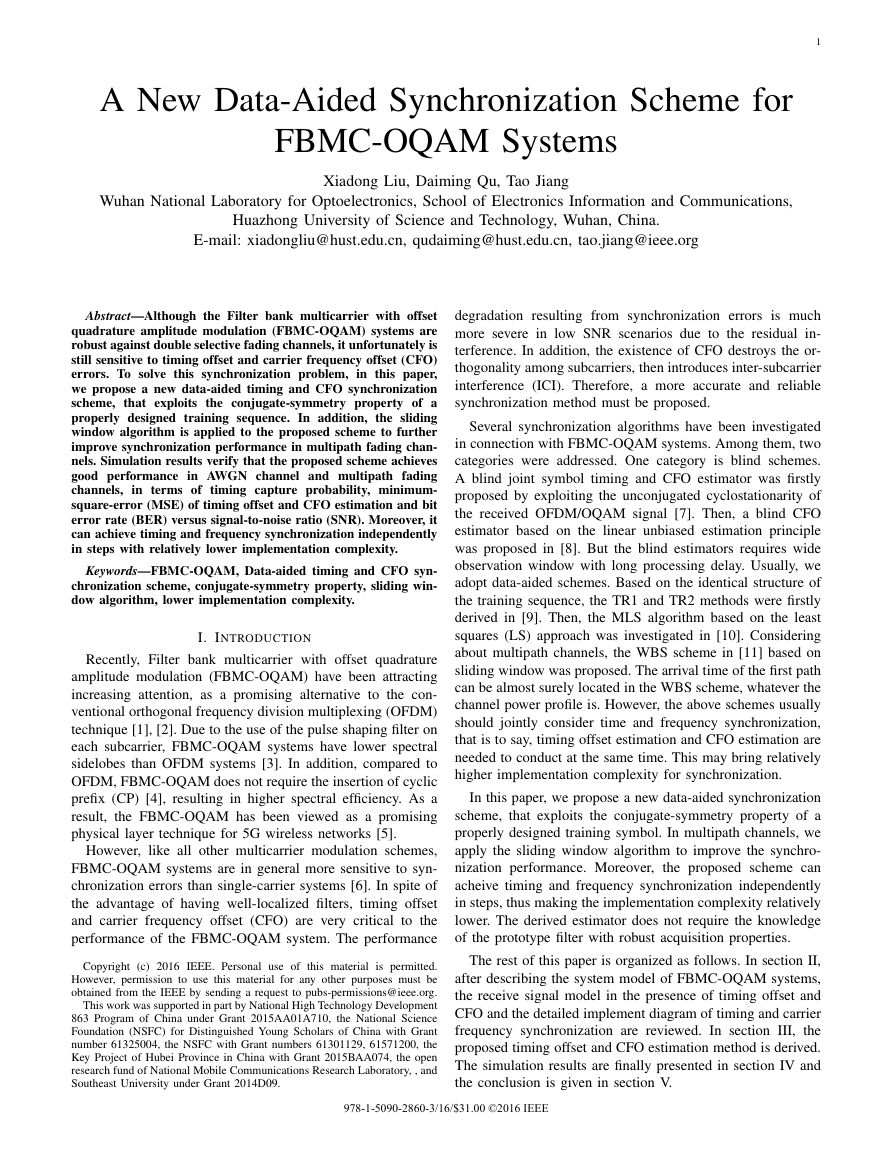
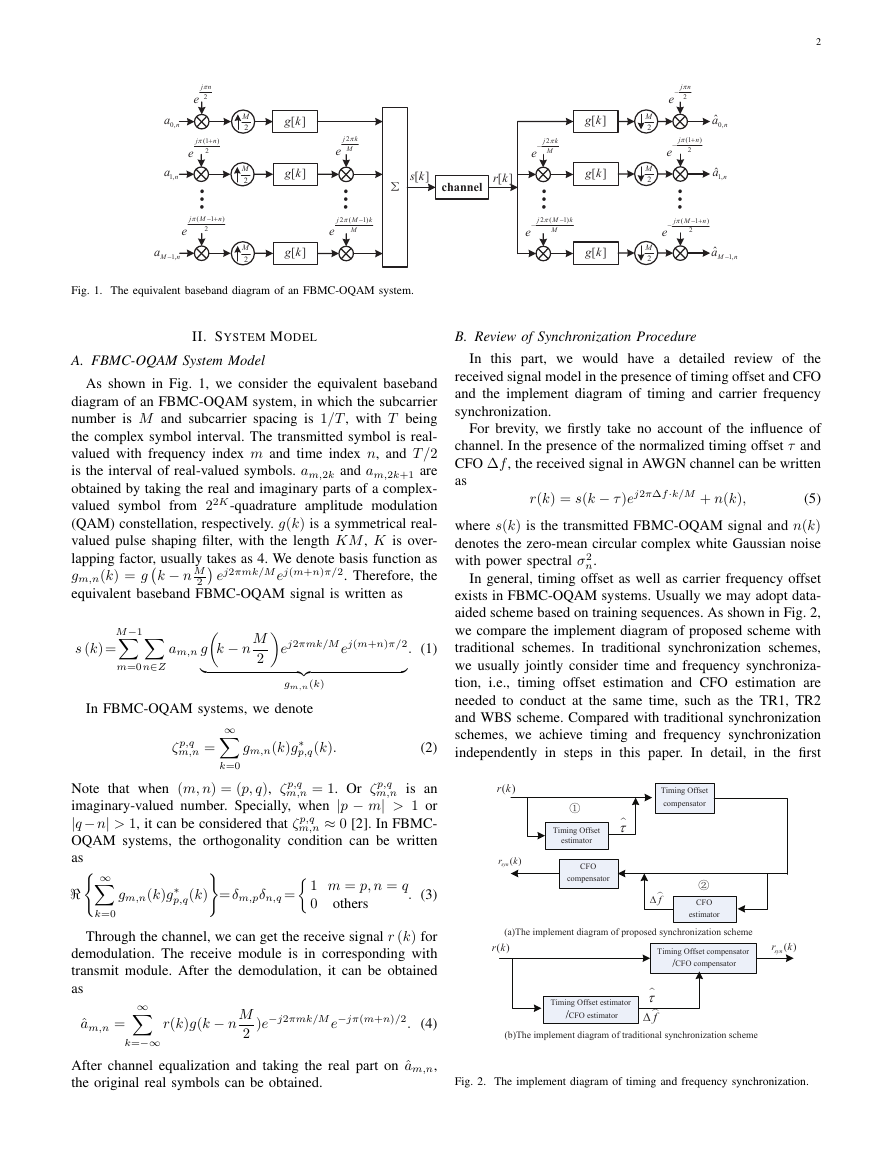
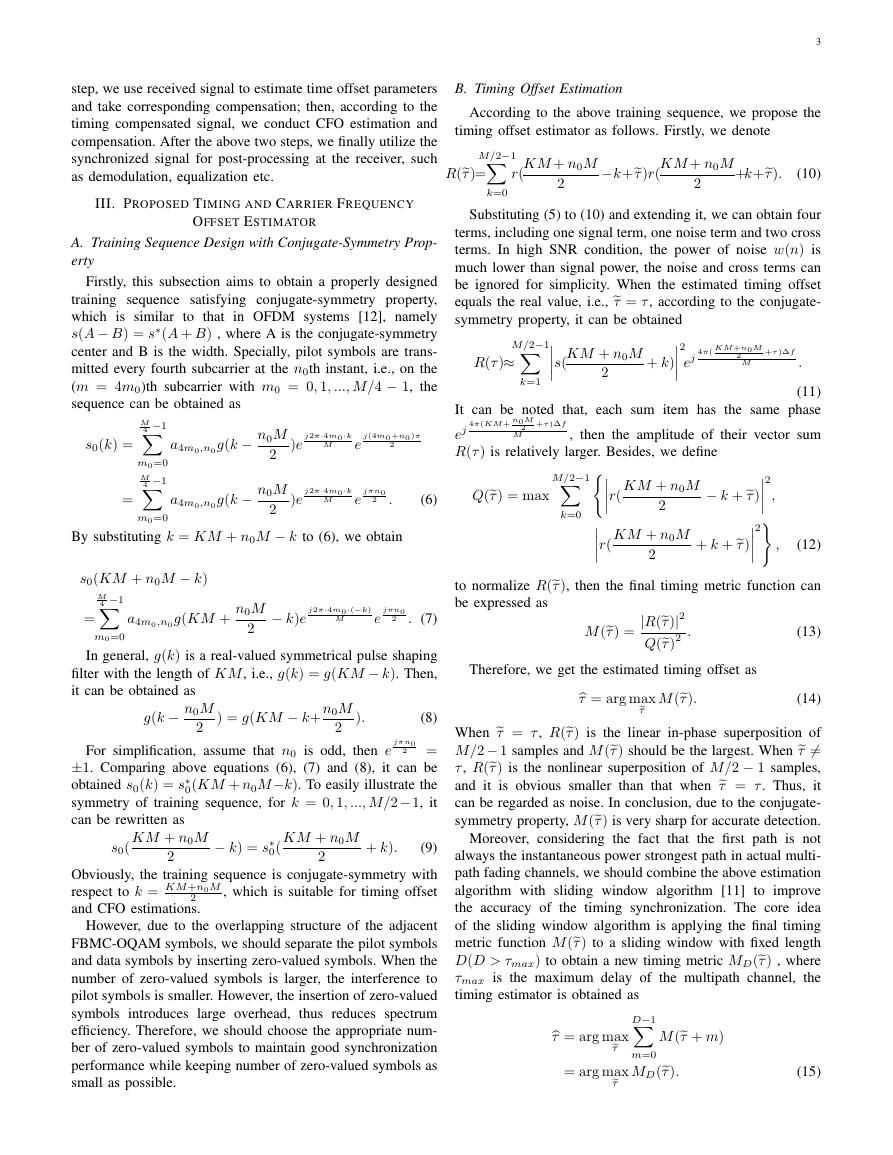
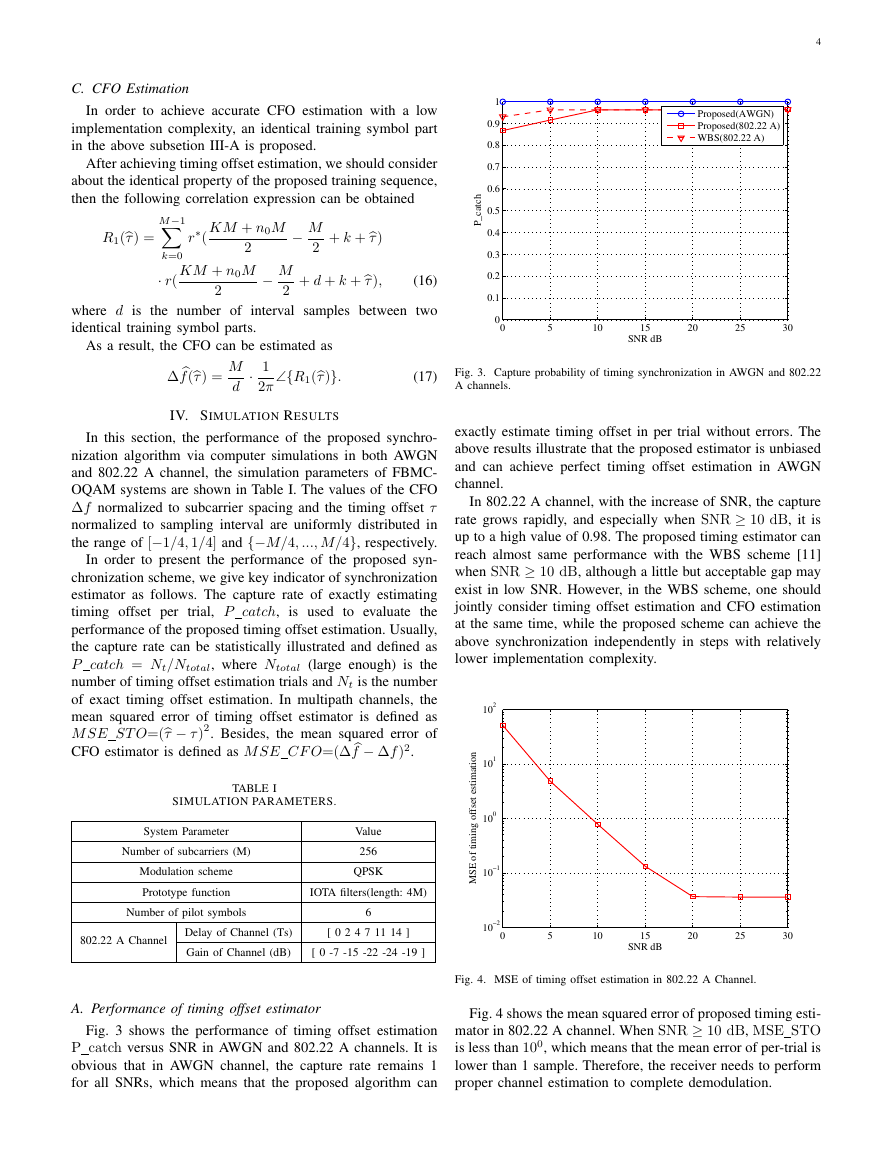
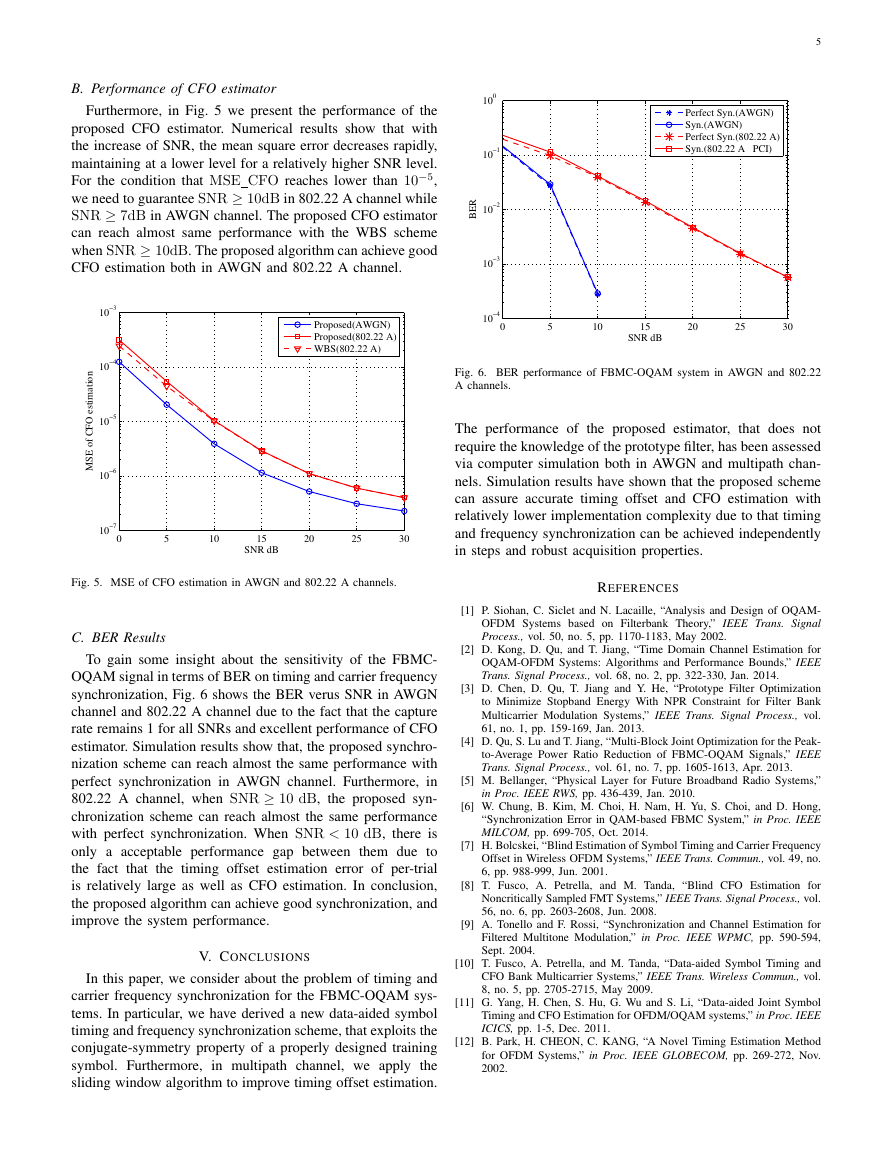





 2023年江西萍乡中考道德与法治真题及答案.doc
2023年江西萍乡中考道德与法治真题及答案.doc 2012年重庆南川中考生物真题及答案.doc
2012年重庆南川中考生物真题及答案.doc 2013年江西师范大学地理学综合及文艺理论基础考研真题.doc
2013年江西师范大学地理学综合及文艺理论基础考研真题.doc 2020年四川甘孜小升初语文真题及答案I卷.doc
2020年四川甘孜小升初语文真题及答案I卷.doc 2020年注册岩土工程师专业基础考试真题及答案.doc
2020年注册岩土工程师专业基础考试真题及答案.doc 2023-2024学年福建省厦门市九年级上学期数学月考试题及答案.doc
2023-2024学年福建省厦门市九年级上学期数学月考试题及答案.doc 2021-2022学年辽宁省沈阳市大东区九年级上学期语文期末试题及答案.doc
2021-2022学年辽宁省沈阳市大东区九年级上学期语文期末试题及答案.doc 2022-2023学年北京东城区初三第一学期物理期末试卷及答案.doc
2022-2023学年北京东城区初三第一学期物理期末试卷及答案.doc 2018上半年江西教师资格初中地理学科知识与教学能力真题及答案.doc
2018上半年江西教师资格初中地理学科知识与教学能力真题及答案.doc 2012年河北国家公务员申论考试真题及答案-省级.doc
2012年河北国家公务员申论考试真题及答案-省级.doc 2020-2021学年江苏省扬州市江都区邵樊片九年级上学期数学第一次质量检测试题及答案.doc
2020-2021学年江苏省扬州市江都区邵樊片九年级上学期数学第一次质量检测试题及答案.doc 2022下半年黑龙江教师资格证中学综合素质真题及答案.doc
2022下半年黑龙江教师资格证中学综合素质真题及答案.doc